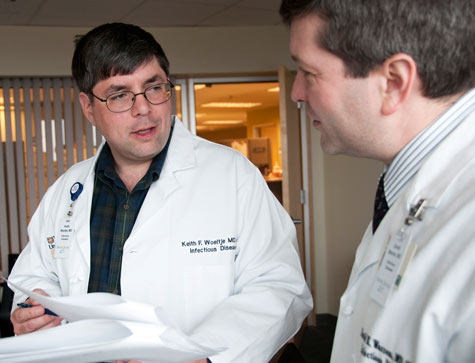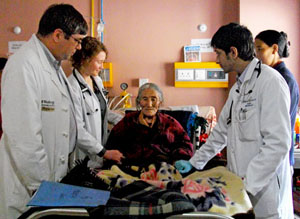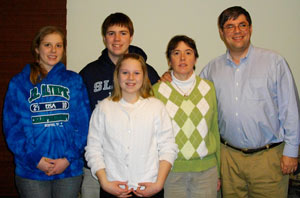
For years, electronic surveillance has been used to track and capture a host of evil suspects — terrorists, mobsters and spies among them.
Keith Woeltje, MD, PhD, associate professor of medicine, relies on electronic surveillance, too. He is a modern-day microbe hunter, tracking bugs that are invisible to the naked eye but capable of causing mayhem in hospitals and adding millions to the cost of treating patients.
While law enforcement uses wiretaps and hidden cameras, Woeltje has taken advantage of computerized medical records to identify and investigate potential hospital-associated infections in real-time and intervene quickly. These infections can cause serious pneumonias and infections of the bloodstream, urinary tract or other areas of the body. In some cases, they are life-threatening.
As a doctor who specializes in infectious diseases and has additional training in medical informatics, Woeltje easily straddles the worlds of medicine and technology with a cool head and an enduring smile.
“Keith stands out because of his upbeat attitude and his willingness to take on new problems and challenges, no matter how daunting they are or how busy he is,” says Vicky Fraser, MD, the J. William Campbell Professor of Medicine and co-director of the Division of Infectious Diseases. “His passion and enthusiasm for preventing hospital-associated infections are contagious. In the midst of an outbreak or epidemic, he is calm and steady and helps everyone else to stay focused.”
Early interest
A native of Arkansas, Woeltje became interested in medicine in elementary school while reading a series of books about legendary figures of medicine and science, including Louis Pasteur, who discovered the germ theory of disease.
“I read those books over and over again,” he says. “I was fascinated by their adventures and discoveries. By the time I was in high school, I knew I wanted to be a doctor.”
Woeltje also was drawn to research and decided to pursue dual MD/PhD degrees at the University of Texas Southwestern Medical School in Dallas. Unlike some medical students who know they want to specialize in a certain field of medicine, Woeltje was decidedly undecided. For a short time, he considered pediatric endocrinology but ultimately questioned whether he had the wherewithal to treat sick children. His brother-in-law, a cardiologist, tried hard to lure him to cardiology, but Woeltje found the specialty too narrow to hold his attention.
Things started to fall into place when Woeltje came to Barnes-Jewish Hospital as an internal medicine resident in 1991. He experienced an “aha!” moment in his second year, during a rotation in infectious diseases with Gerald Medoff, MD, then head of the division and now professor emeritus of and lecturer in medicine.
“He’s such a great teacher, and that experience sealed the deal,” Woeltje says. “Infectious diseases covers the whole body and touches every organ system. Each case is a new mystery. It’s very diverse, and, for me, that keeps things interesting.”
Woeltje stayed at Washington University for a fellowship in infectious diseases and contemplated a career doing laboratory research. But once his fellowship got under way, he was captivated by the clinical experience.
“I saw everything — tropical diseases, HIV and opportunistic infections, transplant and oncology infections, pneumonias and endocarditis,” he says. “It’s really, really busy, and you work really, really hard, but you get tons of exposure to fascinating cases, and you learn a lot.”

Keith Woeltje (far left) recently traveled to Bhutan to help develop public health and hospital infection control programs.
Working with Fraser, then head of epidemiology at Barnes-Jewish Hospital, Woeltje also discovered the thrill of tracking infectious outbreaks in a hospital setting and decided to follow that trail.
At that time, in the mid-1990s, there was a growing awareness of the potential risks of hospital-acquired infections, including central-line-associated bloodstream infections, ventilator-associated pneumonia, catheter-associated urinary tract infections, surgical site infections, Methicillin-resistant Staphylococcus aureus (MRSA) and Clostridium difficile, an intestinal bacteria.
Several large academic medical centers, including Barnes-Jewish Hospital, were just beginning to use computerized microbiology laboratory data to identify infection hot spots on its patient floors.
“I was just taken by it all, and I finally decided that’s what I wanted to do — hospital epidemiology,” he says.
After his fellowship, Woeltje went to the Medical College of Georgia in Augusta, serving on the faculty and as its hospital epidemiologist.
“It may have been a bit of a stretch coming right out of a fellowship, but it’s not as large as Barnes, and I knew I would have a lot of telephone help from here if I needed it,” Woeltje says.
While in Georgia, he also earned a graduate certificate in medical informatics from Oregon Health & Science University in Portland, Ore.
After six years and loads of experience, Woeltje was lured back to Washington University in 2004 by Fraser, who had just been appointed as head of clinical infectious diseases. She needed someone to replace her as medical director of infection control for BJC HealthCare. Woeltje jumped at the opportunity to join the School of Medicine faculty and head infection control efforts at the 13 BJC HealthCare hospitals.
Making a difference
Today, only about one-third of hospitals nationwide use electronic surveillance to track infectious outbreaks, and they tend to be large, academic centers like Barnes-Jewish Hospital. Traditionally, infection surveillance has involved manually reviewing patient charts, which is extremely labor intensive. And it would be virtually impossible to implement manual chart reviews of all patients, especially in a hospital as large as Barnes-Jewish Hospital, with its 1,000-plus beds.

Missouri law requires manual chart review in all intensive care units (ICUs), and all hospital-associated infections in ICUs must be reported to the state health department.
This sounds good in theory, but it takes enormous manpower, Woeltje says, and doesn’t reveal a complete picture.
“Invariably, the ICUs get all the attention because that’s where many infections occur,” he says. “But what about the rest of the hospital?”
For example, central venous catheters often are used to provide hospitalized patients with medications, nutrition and fluids.
“But there are just as many patients with catheters outside the ICUs as there are in them, and the rates of infection are similar,” he says. “By only looking at ICU patients, we’re missing about half the catheter-associated bloodstream infections.”
But many health-care epidemiologists have questioned whether electronic surveillance of infection is just as accurate as manually reviewing patient charts. Woeltje’s research suggests it is.
“We’re finding, at least for bloodstream infections, that we can use fairly simple algorithms, such as whether a patient has a positive blood culture, whether he or she has a central venous catheter in place, and so on, and get rates of infection that are very similar to what you would get by manually reviewing charts,” he says.
With electronic surveillance, Woeltje and his colleagues can get data on every unit in the hospital. When a problem occurs, infection prevention specialists receive a “red alert.” While the physician overseeing the patient’s care in the hospital is responsible for treating the infection, Woeltje and his team intervene to reduce the further spread of infection.
This can include educating staff on established practices to control infections, such as making sure doctors and patients are covered from head to toe with sterile gowns while intravenous catheters are inserted. Or, in the case of patients on a ventilator, keeping their heads upright and removing the breathing tubes as soon as possible. Woeltje also uses electronic surveillance to monitor whether interventions successfully prevent future infections.
With more attention paid to hospital-associated infections, the rates at Barnes-Jewish Hospital have dropped substantially, aided by the use of electronic monitoring.
“Our rates are much lower than they were 10 years ago,” Woeltje says. “Some of our ICUs will go months or over a year with no bloodstream infections.”
As a clinician, Woeltje is sought by other specialists throughout the medical school for consultation on difficult cases. He is admired for his careful analysis of patients and his practical and cost-effective delivery of medical care.
“Keith is always willing to go the extra mile for his patients and for his colleagues,” says David Warren, MD, assistant professor of medicine. “He’s an excellent clinician. If there’s a difficult case, he is the one many of us go to for advice.”
Woeltje also is eager to share his knowledge with medical students, residents and professional colleagues, including those in far-flung areas of the globe. He has traveled to Serbia, Thailand and, in February, to Bhutan to help develop public health and hospital infection control programs.
”I love working at Washington U. — it’s a great place to be a doctor,” he says. “We have interesting patients, a world-class hospital and really smart colleagues to work with. I enjoy coming to work everyday — most days, anyway.”
Fast facts about Keith Woeltje
Title: Associate professor of medicine, Division of Infectious Diseases; medical director, Infection Control and Healthcare Epidemiology Consortium, BJC HealthCare
Education: BS, biochemistry, University of Dallas; MD, University of Texas Southwestern Medical School; PhD, University of Texas Southwestern Graduate School of Biomedical Sciences
Family: Wife, Gabrielle; children Maeve, 17, John, 15, and Éile, 12
Hobbies: Computers, do-it-yourself electronics, reading and visiting microbreweries